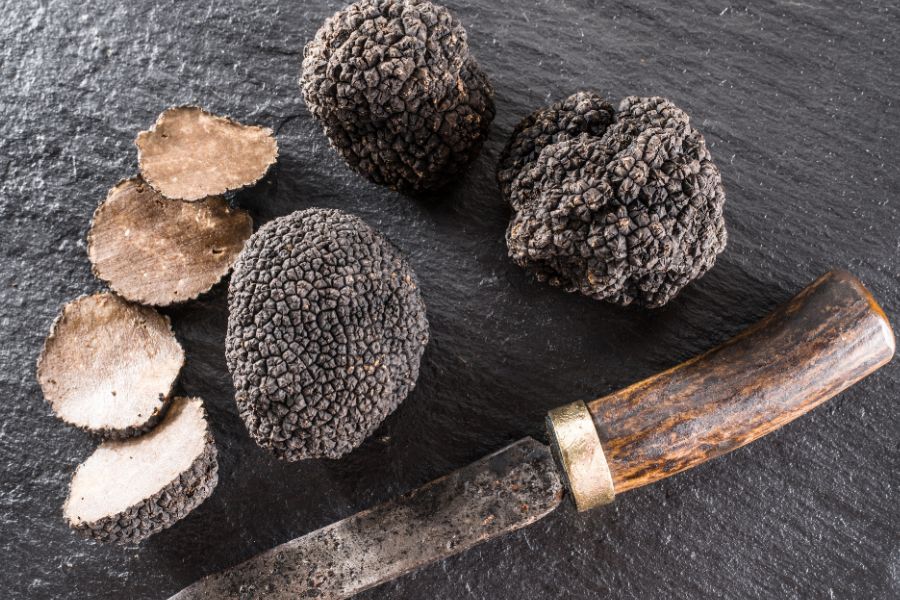If you’re wondering where to find truffles in Georgia, you’re not alone. Most people think of France or Italy when it comes to truffles, but several species grow right here in the southeastern U.S. In the forests of Georgia, you’ll find native truffles hiding underground near oak, pine, and beech trees.
Georgia’s warm, humid climate supports a variety of native truffle mushrooms. These aren’t the exact truffles found in Europe, but they’re still aromatic and highly prized by wildlife—and increasingly by foragers.
There’s no public map to where these fungi grow, so your success depends on knowing what types of trees and soil to target. If you’re curious where in Georgia these underground treasures are hiding, it might be time to take a closer look at what’s beneath your feet.
What We Cover In This Article:
- What Wild Truffles Look Like
- Truffle Lookalikes To Avoid
- Best Practices For Finding Truffles
- Where You Can Find Truffles Around The State
- Other Great Locations For Truffles
- When The Best Time Of The Year Is To Find Truffles
- The extensive local experience and understanding of our team
- Input from multiple local foragers and foraging groups
- The accessibility of the various locations
- Safety and potential hazards when collecting
- Private and public locations
- A desire to include locations for both experienced foragers and those who are just starting out
Using these weights we think we’ve put together the best list out there for just about any forager to be successful!
A Quick Reminder
Before we get into the specifics about where and how to find these plants and mushrooms, we want to be clear that before ingesting any wild plant or mushroom, it should be identified with 100% certainty as edible by someone qualified and experienced in mushroom and plant identification, such as a professional mycologist or an expert forager. Misidentification can lead to serious illness or death.
All plants and mushrooms have the potential to cause severe adverse reactions in certain individuals, even death. If you are consuming wild foragables, it is crucial to cook them thoroughly and properly and only eat a small portion to test for personal tolerance. Some people may have allergies or sensitivities to specific mushrooms and plants, even if they are considered safe for others.
The information provided in this article is for general informational and educational purposes only. Foraging involves inherent risks.
What Wild Truffles Look Like
The U.S. is home to several native truffle species that grow wild in forests across the country. Each one has its own unique scent, appearance, and preferred habitat. Here are the types of truffles you can find:
Oregon Black Truffles (Leucangium carthusianum)
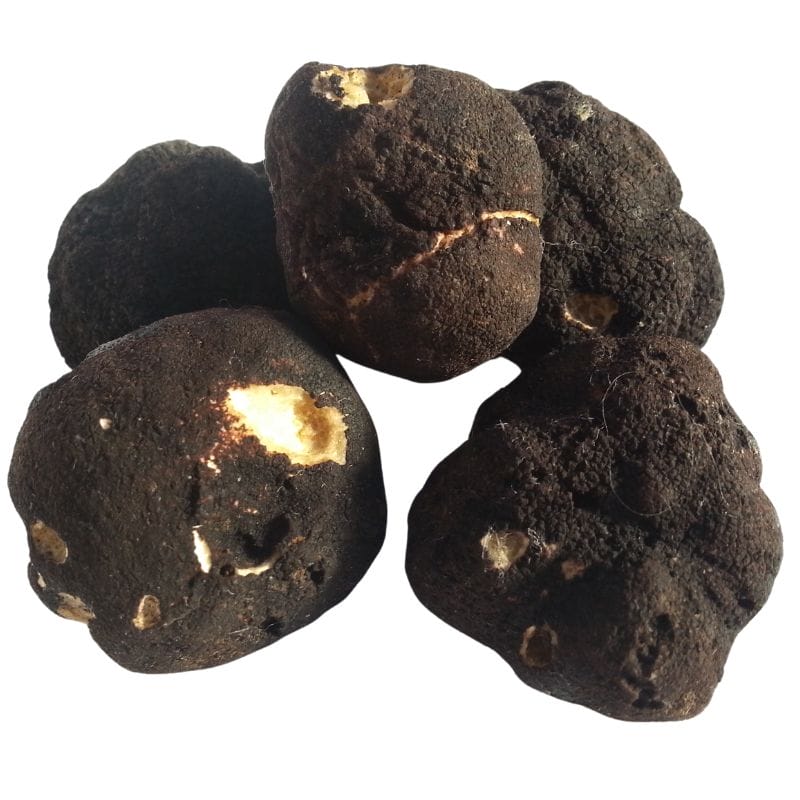
Leucangium carthusianum, also called the Oregon black truffle, grows in the Pacific Northwest and usually shows up around Douglas-fir trees. It’s a native species and one of the more well-known edible truffles from the region.
On the outside, it looks like a small lump of coal—dark black, kind of lumpy or warty, and sometimes slightly smoother in spots. They’re usually about the size of a golf ball, but they can be smaller or larger depending on the season.
Inside, the truffle is firm with a marbled pattern of gray and white veins running through it. When it’s fresh, it smells fruity, almost like pineapple, but the scent gets stronger and muskier as it ripens.
If you’re out looking for them, check in moist, shady forests with soft, loamy soil, especially where there’s a lot of moss or ferns. They grow just below the surface, so people often use trained dogs to help sniff out the ripe ones.
Compared to the Oregon white truffle, which is lighter in color and has a sharper, garlicky aroma, the black truffle has a deeper, more earthy smell. It’s also bigger and firmer than the southern U.S. truffles like Tuber lyonii, which tend to be smaller, paler, and grow around hardwoods like oaks and hickories.
Oregon Winter White Truffles (Tuber oregonense and Tuber gibbosum)
Oregon has two native white truffles that are starting to get more attention: the Oregon Winter White Truffle (Tuber oregonense) and the Oregon Spring White Truffle (Tuber gibbosum). They grow underground in forests and are prized for their strong, savory aroma.
From the outside, these truffles are small, roundish, and kind of bumpy, usually pale beige to light brown. Cut one open, and you’ll see a white interior that darkens with age, showing off a web of white veins when it’s fully mature.
The Winter White Truffle pops up from late fall into February, while the Spring White starts showing up around January and can last into June. They’re pretty similar, but the Winter variety is known for having a more powerful scent and flavor.
To find them, you’ll want to look in forests with younger Douglas-fir trees on the west side of the Cascades. Truffle hunters often check for loose soil or spots where animals have been scratching, which can be a sign there’s something below.
When fully ripe, both types give off a bold smell that’s often compared to garlic, cheese, or earthy spices. They’re usually served raw, shaved over dishes to add that truffle kick without losing any of the aroma.
Appalachian Truffle (Tuber canaliculatum)
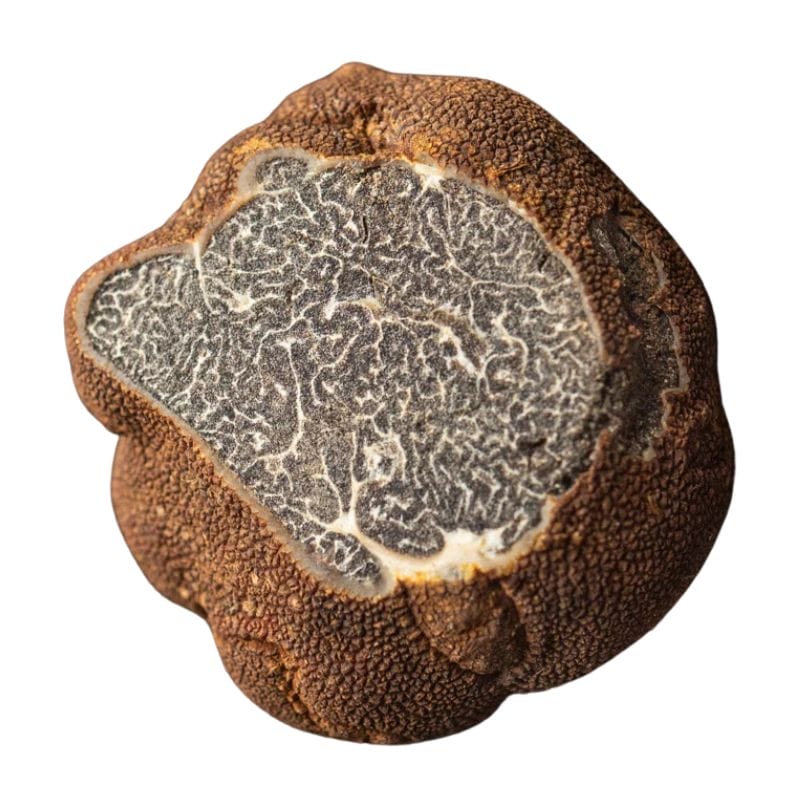
The Appalachian truffle, also known as Tuber canaliculatum, is a native North American truffle that’s slowly getting noticed. It’s about the size of a walnut and has a reddish-brown, bumpy outer surface that looks kind of like a rough, warty potato.
When you cut it open, the inside is firm and dark brown with thin white veins running through it like a marbled pattern. If it’s fully ripe, the smell is strong and earthy—some say it has a kind of nutty, funky aroma that stands out.
You can find these truffles in mixed hardwood forests, especially around oaks and pines, from late summer through fall. They grow underground, so look for spots where the soil is loose and animals like squirrels have been digging—sometimes that’s a good clue.
If you’re foraging, gently raking the top layer of soil near tree roots can help, but a trained dog or even a good nose makes it way easier. Once you know what to look for, the reddish color and bumpy skin are good signs you’ve found the right thing.
Compared to truffles like Tuber oregonense or Leucangium carthusianum, Tuber canaliculatum is more subtle in every way. Its smaller size and lighter scent mean you have to pay closer attention when foraging.
It’s also not as popular in the culinary world because it doesn’t pack the same punch in terms of flavor or aroma. Still, finding one can be rewarding, especially if you’re exploring different types of fungi in the area.
Desert Truffle (Terfezia and Tirmania spp.)
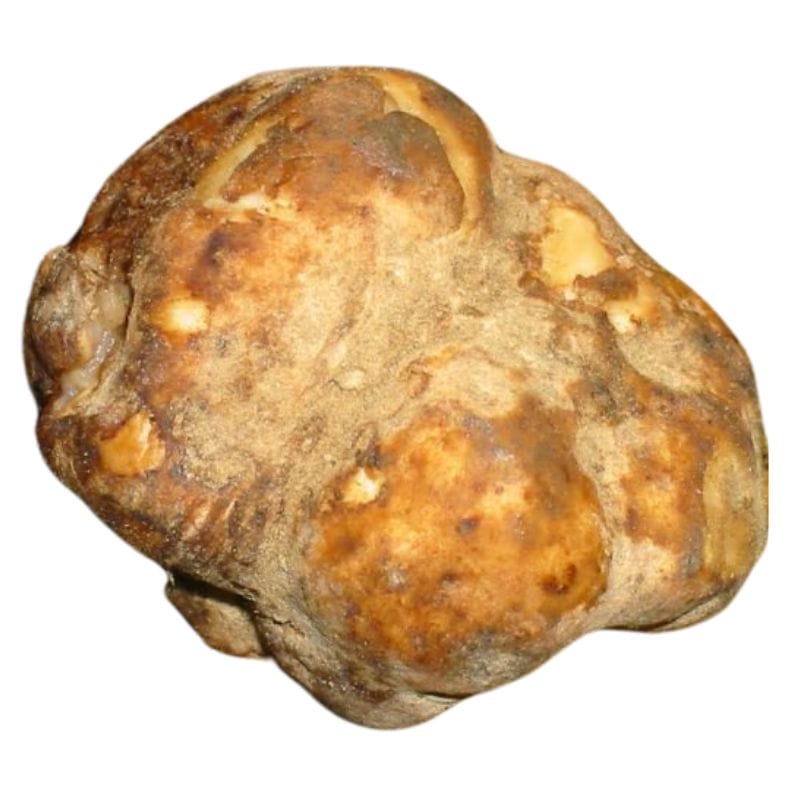
Terfezia and Tirmania are two types of truffles that are sometimes called desert truffles. These are a bit different from the truffles we usually think of, with their bold flavors and rich aromas.
These ones are a little more understated, but they’re fascinating in their own right. What makes them stand out is their ability to thrive in dry, harsh environments where you wouldn’t expect something so delicate to grow.
Unlike the earthy, intense aroma of black or white truffles, Terfezia and Tirmania truffles have a milder scent and flavor. They’re often described as nutty, with a hint of sweetness, but they lack the strong garlicky or musky notes you might associate with other truffles.
Their texture is also different—more firm and less oily than what you’d find with species like Tuber oregonense. They might not have the same culinary punch, but they’re still prized in traditional dishes, where their subtle flavors shine in simpler recipes.
When it comes to appearance, they’re easy to spot once you know what you’re looking for. They’re round to slightly irregular in shape, and their color can range from light beige to a reddish-brown, depending on the species.
The surface is usually smooth or slightly textured, without the rough, knobby look of a black truffle. Cut one open, and you’ll see a pale interior that’s often uniform in color, lacking the intricate veining you’d see in something like Leucangium carthusianum.
Pecan Truffle (Tuber lyonii)
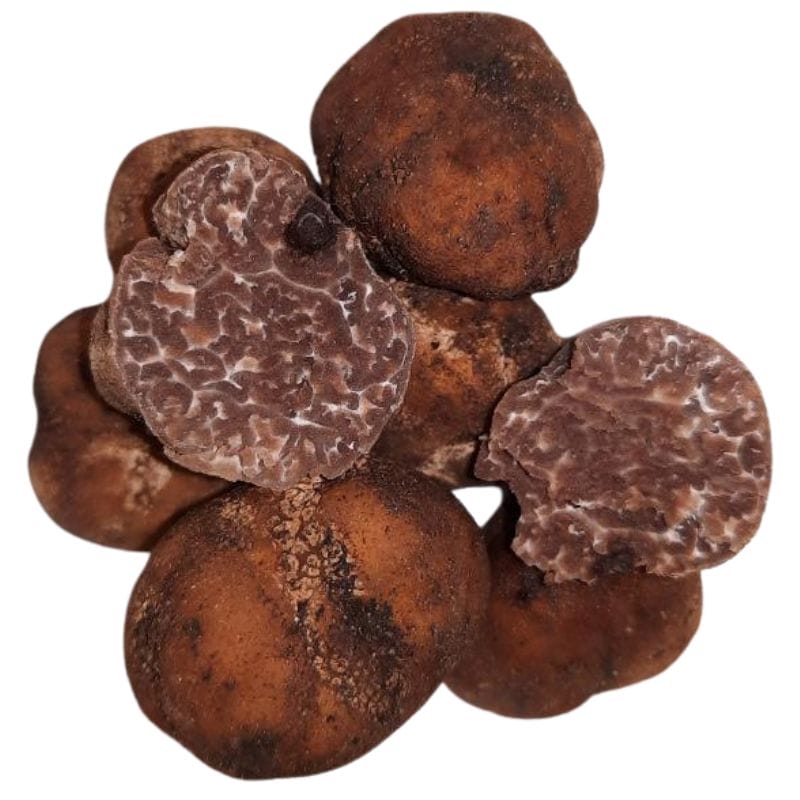
Tuber lyonii, also known as the pecan truffle, is a native North American truffle that grows underground near the roots of pecan trees. You’ll mostly find it in the southeastern U.S., especially in states like Texas, Georgia, and Mississippi.
On the outside, pecan truffles are round to lumpy and have a smooth, light brown skin that darkens as they age. They’re usually about the size of a marble or golf ball, and sometimes they even poke up slightly through the soil surface.
If you slice one open, the inside has a pretty marbled look—light tan streaks mixed with darker brown, almost like wood grain. The smell is earthy, nutty, and kind of warm, especially when they’re fully mature.
When you’re out looking for them, check under mature pecan trees or other hardwoods like oaks and hickories. Trained dogs can help sniff them out, but people sometimes spot them by looking for little cracks in the soil or raised areas near the tree’s base.
Compared to other U.S. truffles like the Oregon white truffle or the Appalachian black truffle, pecan truffles have a milder flavor and are more common in orchards. They’re a solid option in the kitchen—freshly sliced over pasta or mixed into butter—and they don’t come with the high price tag of their European cousins.
Truffle Lookalikes To Avoid
When you’re out hunting you also need to know about a few different fungi species that look very similar to the delicious truffles we’re after but are either inedible or not worth eating. Keep an eye out for:
Pine Truffles (Geopora cooperi)

Geopora cooperi is a fungus that can easily confuse someone new to truffle hunting. It’s sometimes called the pine truffle because it grows underground like a true truffle and often pops up near certain trees.
At first glance, it might seem like you’ve hit the jackpot, but this one is a false truffle, not something you’d want to eat or sell.
The easiest way to tell Geopora cooperi apart from real truffles is by looking closely at its structure. While true truffles have a smooth or slightly knobby exterior and a marbled interior, Geopora cooperi has a rougher, more irregular outer surface.
When it matures, it sometimes splits open, revealing a cup-like shape, which true truffles never do. Inside, it’s less dense and doesn’t have the intricate veining that makes real truffles so unique.
Another big difference is the smell. True truffles have a strong, rich aroma that’s earthy, sweet, or garlicky, depending on the species. Geopora cooperi, on the other hand, has a much weaker scent, and it’s not as pleasant or distinctive.
If you’re relying on aroma to identify your find, this one will give itself away pretty quickly. So, while it might look similar at first, a closer inspection will show it’s not the culinary treasure you’re hoping for.
Stinking Slime Truffle (Melanogaster ambiguus)
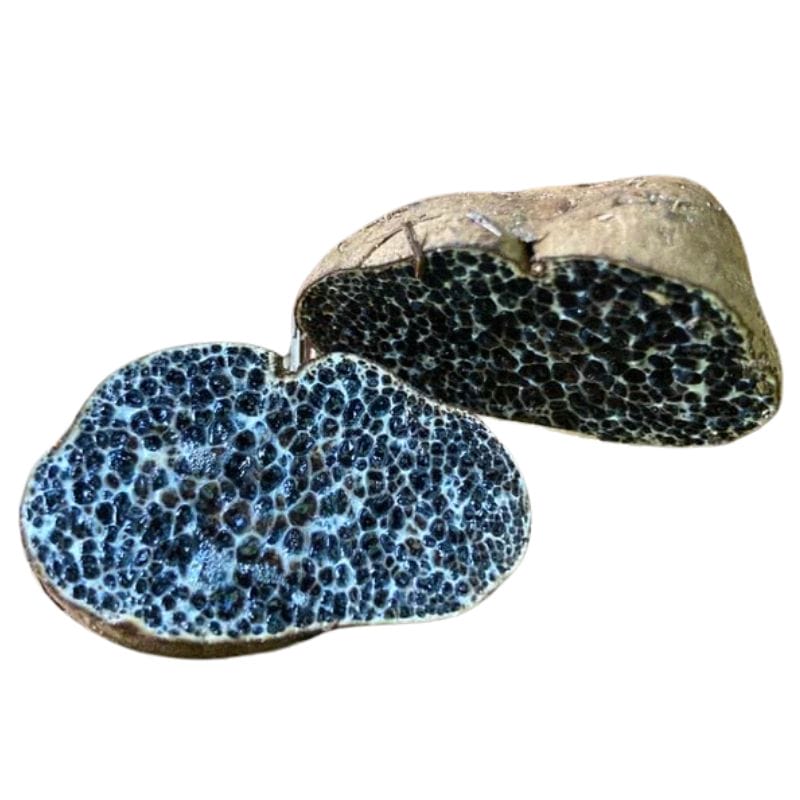
Melanogaster Ambiguus, because of their reddish-brown to dark brown exterior, might look like true truffles at first glance, but they’re quite different when you know what to look for.
The key difference is on the inside. When you cut open Melanogaster ambiguus, the interior is filled with flattened cells that have a shiny black gelatinous feel to them. Real truffles, on the other hand, have those beautiful marbled veins running through their flesh, almost like a web.
Another giveaway is the smell. While real truffles have a rich, earthy aroma that’s mouthwatering, Melanogaster ambiguus tends to have a much stronger, almost unpleasant odor—it’s not something you’d want to sprinkle on your pasta.
Earthballs (Scleroderma)
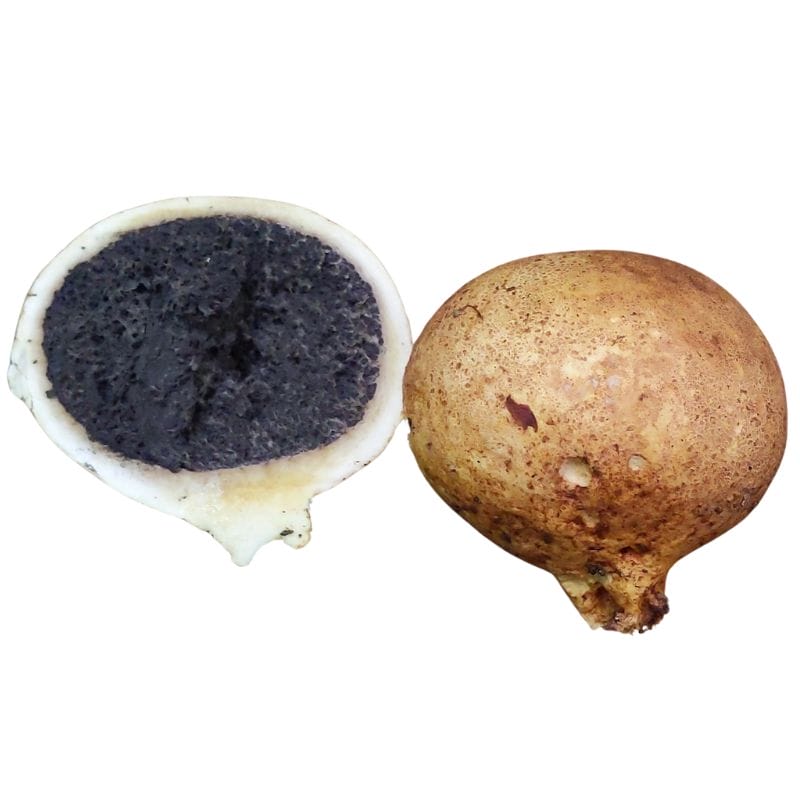
Scleroderma, commonly called earthballs, can easily fool someone who’s just starting out because they grow underground and have a round shape similar to truffles. But don’t be tricked—Scleroderma is not a true truffle, and it’s actually toxic, so it’s important to know how to tell the difference.
The first thing you’ll notice is the outer skin, which is thicker and tougher than that of most truffles. It can range in color from yellowish to dark brown, often with a rough or cracked texture.
If you cut it open, the difference becomes even clearer. While true truffles have a marbled interior with delicate white veins, Scleroderma starts out with a whitish inside that quickly darkens as it matures, turning black or purple with no marbling. It’s dense and solid, almost like charcoal in the later stages.
Another big giveaway is the smell. True truffles have a rich, earthy aroma that makes them so prized, while Scleroderma has little to no pleasant scent—some even describe it as musty or unpleasant.
Deer Truffles (Elaphomyces)
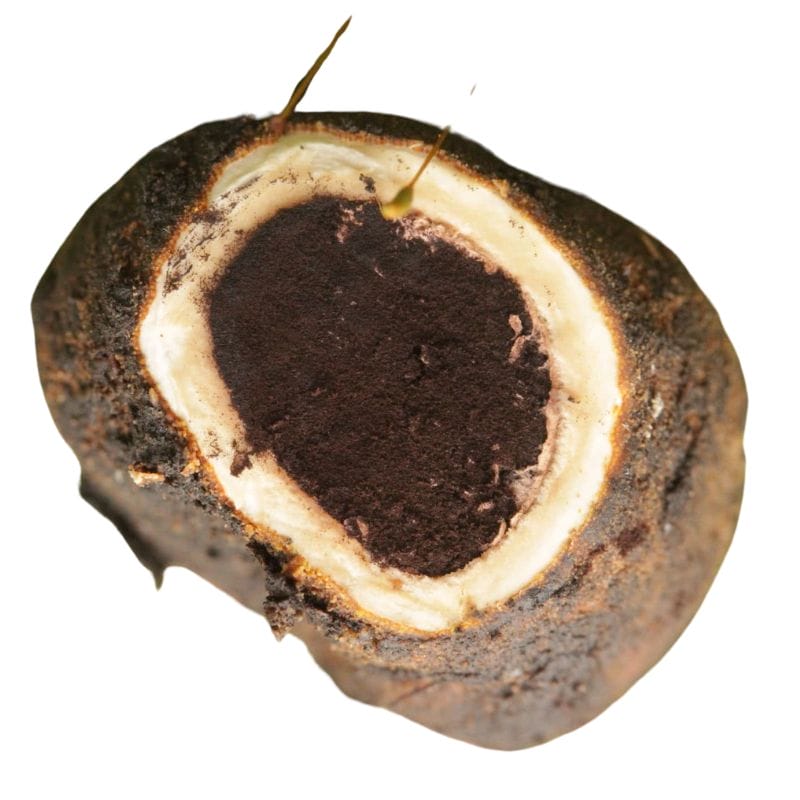
Elaphomyces, also known as deer truffles, look like true truffles at first glance, but they’re a whole different story. They’re called deer truffles because wildlife, especially deer and rodents, love to eat them. For us humans, though, they’re not edible—and definitely not what you want to mistake for a prized truffle.
Here’s how you can tell Elaphomyces apart from the real thing. First, they have a tough, warty outer surface that can range from pale tan to black, depending on the species and their age.
When you cut them open, the inside is solid and sometimes speckled or marbled, but not in the delicate, vein-like pattern you’d see in true truffles.
Their smell is also a big giveaway. Instead of the rich, earthy aroma of an edible truffle, Elaphomyces either has little scent or an odor that’s earthy but not particularly appealing.
Another thing to know is that Elaphomyces often grows deeper in the soil than true truffles, and they tend to have a harder, woodier texture.
Best Practices For Finding Truffles
Truffle hunting can be a rewarding adventure if you know the right tips and tricks. Here’s what you should keep in mind to improve your chances of finding these underground treasures:
Wait 10 to 14 Days After Heavy Rain
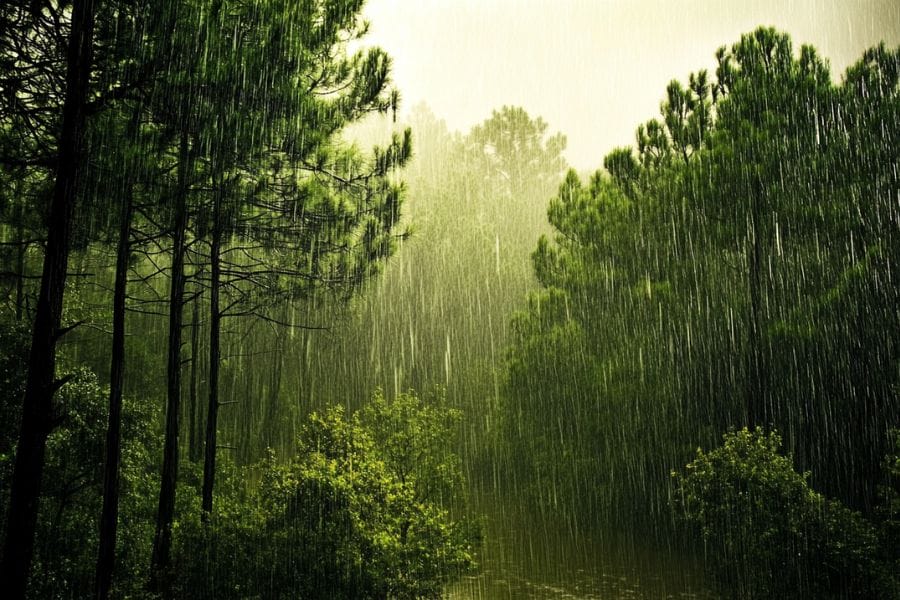
After a heavy rain, it’s best to wait about 10 to 14 days before heading out. This gives the truffles time to mature and release their signature aroma, making it easier for you (and your dog) to sniff them out. Rain helps truffles grow, but they don’t start giving off their scent right away.
As the soil warms up, the truffles get more aromatic, and the ground becomes looser, which makes digging easier without disturbing the environment too much. The timing is perfect to find truffles at their best—both in quality and in how easy they are to locate.
Find the Right Trees

Truffles don’t grow just anywhere—they have a special relationship with certain trees. You won’t find them under just any tree, so knowing which ones to look for can make all the difference. Some of the best trees to look out for are:
- Pines
- Douglas-firs
- Oaks
- Hazelnuts
- Cypresses
- Willows
For example, if you’re looking for Oregon white truffles, keep an eye out for Douglas-fir trees. California black truffles, on the other hand, are often found near oaks and hazelnuts. The soil around these trees also needs to be slightly alkaline, so it helps to know what kind of ground you’re walking on as well.
Watch for Wildlife Activity
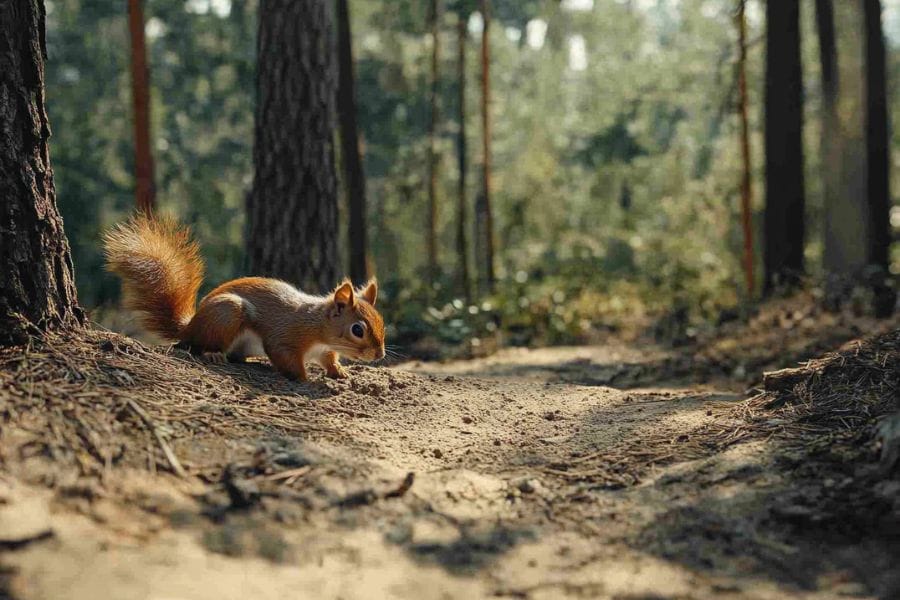
Animals like squirrels and chipmunks often help spread truffle spores, and sometimes their digging can lead you straight to truffles. While you won’t always find truffles in every pit animals dig (they also look for things like acorns or bulbs), fresh digs are a good clue. The more recent the pit, the better chance it has of leading to truffles.
Even though animals are a part of the truffle cycle, most hunters prefer using dogs to find the real treasure underground. Dogs have an incredible nose for truffles and can pinpoint their location much more reliably than any squirrel or chipmunk.
Get a Little Help from a Truffle-Hunting Dog
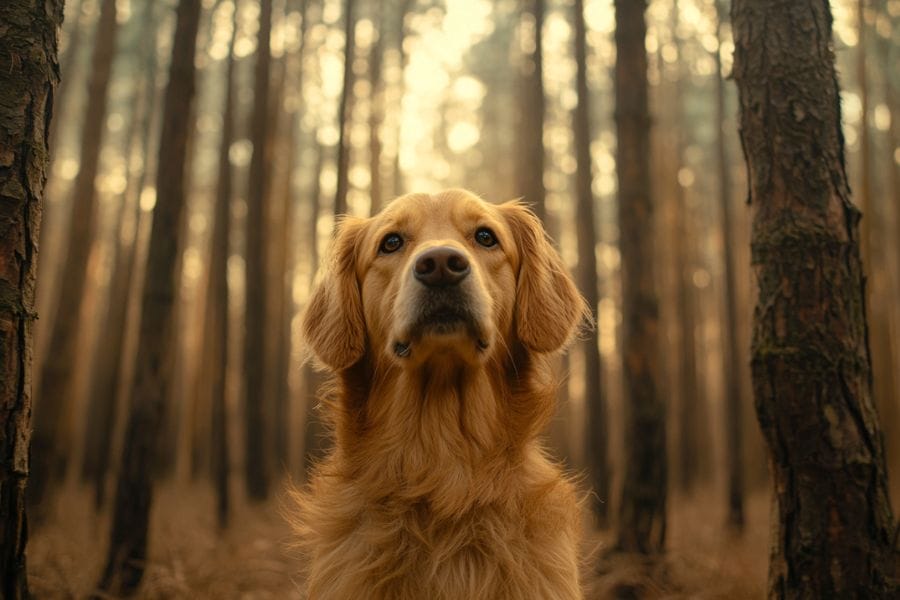
If you’re serious about truffle hunting, a trained dog can make your life a whole lot easier. Their sense of smell is extraordinary, and they’re trained to find mature truffles buried beneath the surface. Many truffle hunters swear by their dogs, and for good reason—they’re much more accurate than humans when it comes to sniffing out truffles.
If you don’t already have a trained dog, you can connect with local foraging groups or specialized trainers who offer truffle-hunting services. Some places even host events where you can see experienced handlers with their dogs in action. And if you’re feeling adventurous, you can train your own dog using truffle-scent kits and practice in a controlled space before hitting the woods.
Before you head out
Before embarking on any foraging activities, it is essential to understand and follow local laws and guidelines. Always confirm that you have permission to access any land and obtain permission from landowners if you are foraging on private property. Trespassing or foraging without permission is illegal and disrespectful.
For public lands, familiarize yourself with the foraging regulations, as some areas may restrict or prohibit the collection of mushrooms or other wild foods. These regulations and laws are frequently changing so always verify them before heading out to hunt. What we have listed below may be out of date and inaccurate as a result.
Where You Can Find Truffles Around The State
Now we’re going to go over five of the best locations for finding truffles. We’ll go a bit in-depth here and then provide a much longer list of other spots to try.
Dawson Forest

Dawson Forest is a large tract of land in north Georgia that spans over 10,000 acres. The forest is known for its diverse ecosytem with a mix of hardwood forests and pine stands. These oak and pine areas create the perfect environment for truffles to grow. Many locals visit the forest for hiking, hunting, and now truffle hunting.
Truffles here tend to grow near the edges of the forest where sunlight filters through the canopy. Look for areas with a mix of young and mature oak trees, especially in the northern section of the forest. The soil in these spots is often loose and well-drained.
To find the best truffles, search in the shallow depressions where fallen leaves accumulate. These micro-environments trap moisture and create ideal conditions for truffle development. The eastern trails often lead to excellent truffle grounds.
Oaky Woods WMA
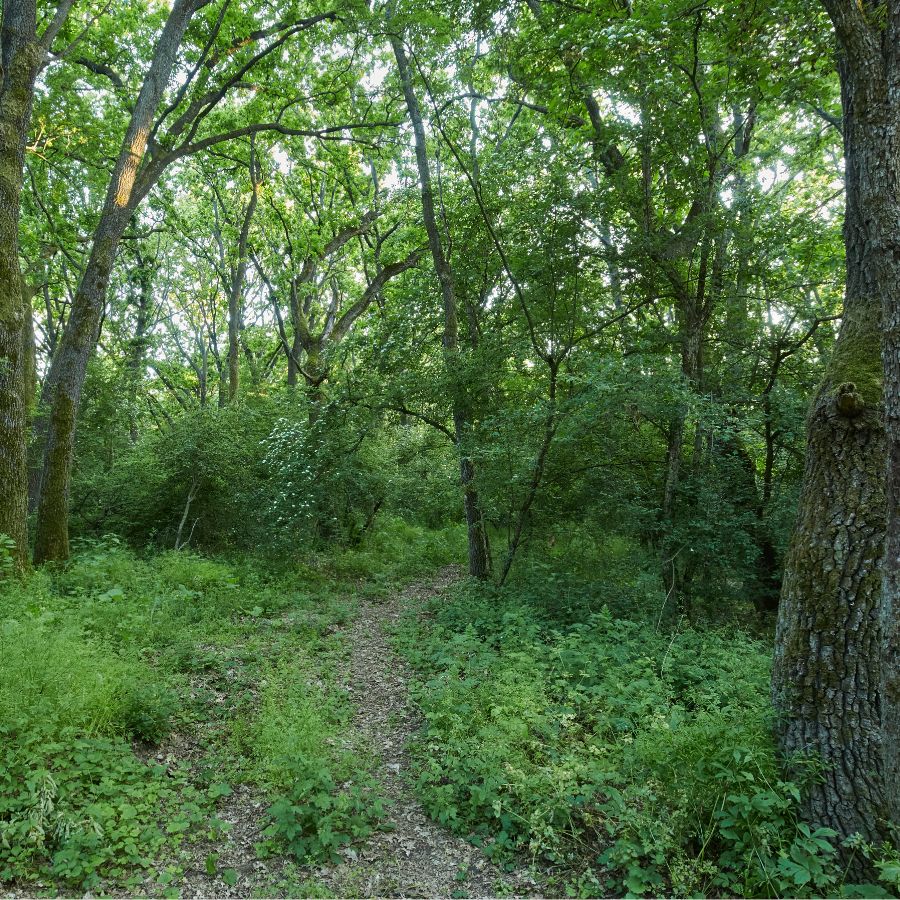
Oaky Woods Wildlife Management Area covers nearly 12,000 acres in Houston County. This remarkable wilderness area is home to Georgia’s black bear population and features a diverse landscape of bottomland hardwoods and upland forests.
Streams and wetlands cut through the property, creating a mosaic of different habitats. The mix of oak, hickory, and other hardwood trees provides excellent conditions for wild truffles.
For truffle hunting, focus on the areas where mature oak trees grow in clusters. These spots often have rich soil with the right fungi networks for truffles. The western portion of the management area tends to be less visited and might offer undisturbed truffle patches.
Look around decaying logs or stumps, as these areas often harbor truffle colonies. The natural mulch created by years of leaf fall creates a perfect habitat. Bring a small rake to gently move away the top layer of soil when searching.
Altamaha WMA
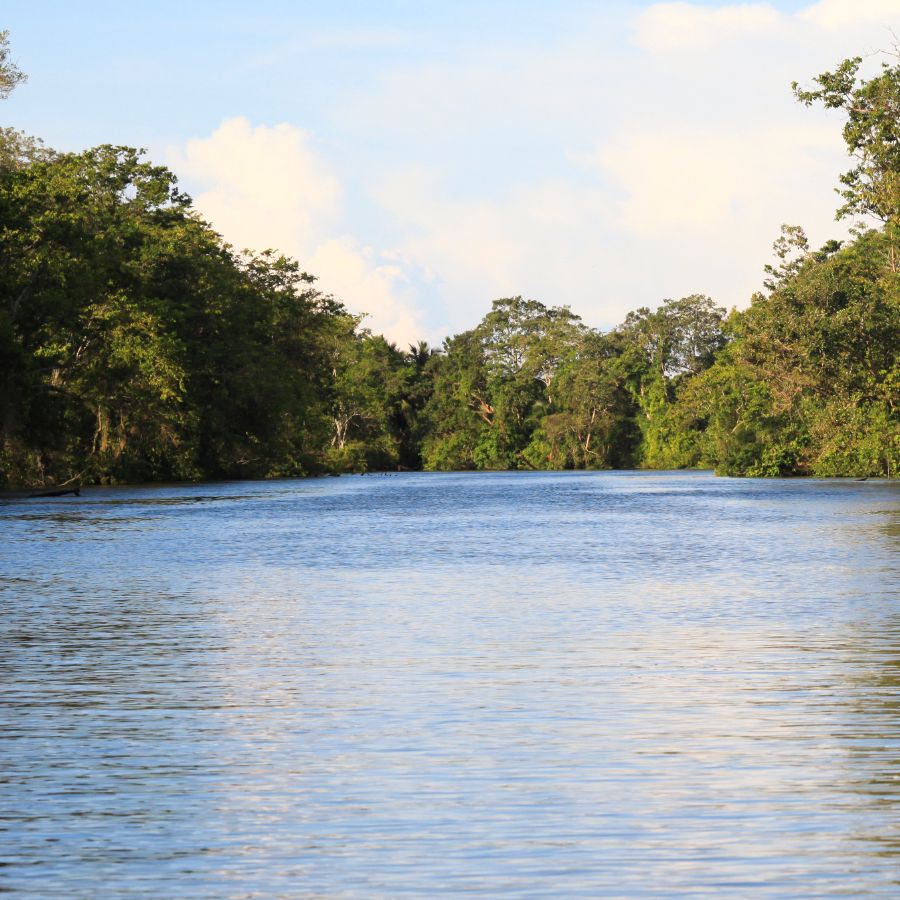
Altamaha Wildlife Management Area is a vast wetland complex located in the coastal region of Georgia. The area encompasses over 27,000 acres of diverse habitats, including cypress swamps, hardwood bottoms, and pine uplands.
This WMA is primarily known for its incredible biodiversity and excellent hunting and fishing opportunities. Water defines this landscape with the mighty Altamaha River flowing through it.
Truffle hunters should explore the slightly elevated areas where water rarely floods. These “islands” often support oak and hickory trees that form symbiotic relationships with truffles. During dry periods, check the soil around trees at the edges of wetlands.
The northern access points provide entry to some less-explored areas that may harbor untouched truffle grounds.
Chickasawhatchee WMA
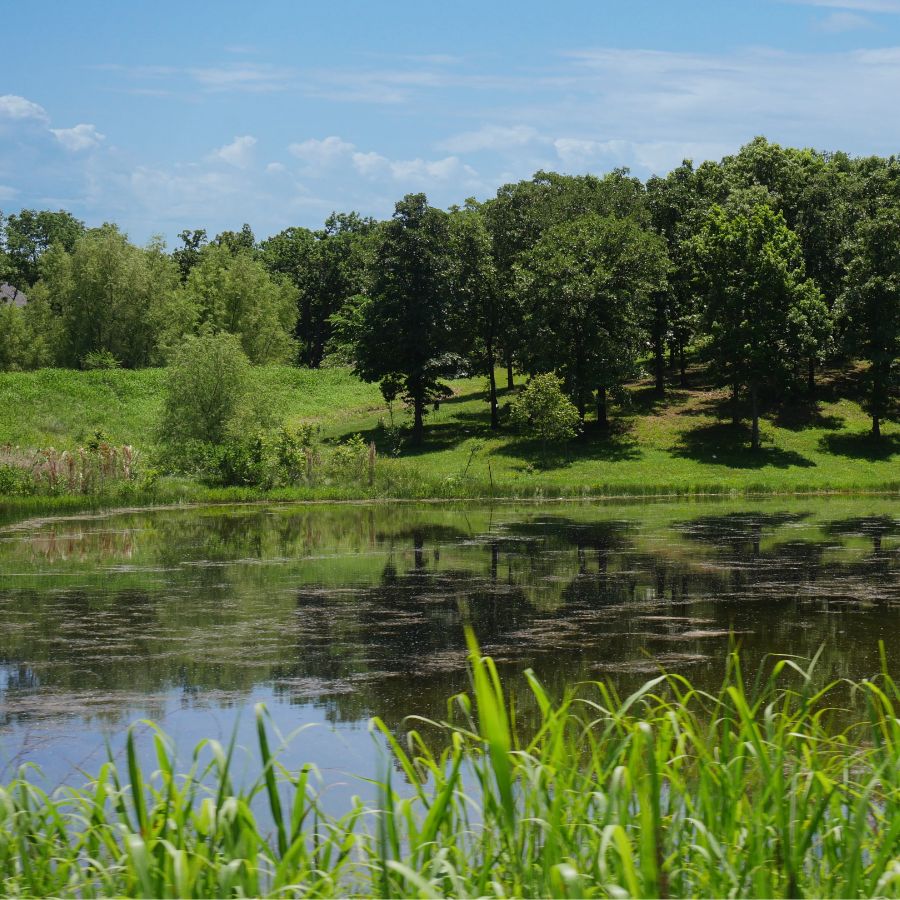
Chickasawhatchee Wildlife Management Area stands as Georgia’s largest wetland complex. Located in southwest Georgia, this 19,700-acre wilderness features a unique karst topography with limestone sinkholes and underground water systems.
For successful truffle hunting, explore the transitions between wetland edges and upland forests. These ecological boundary zones often harbor the fungal networks that support truffle growth. The southern portions of the WMA have some excellent truffle territory near the mature oak stands.
Check areas with partial sun exposure where the canopy isn’t completely closed. Truffles here seem to prefer the slightly alkaline soils that develop over the limestone bedrock.
Dixon Memorial State Forest
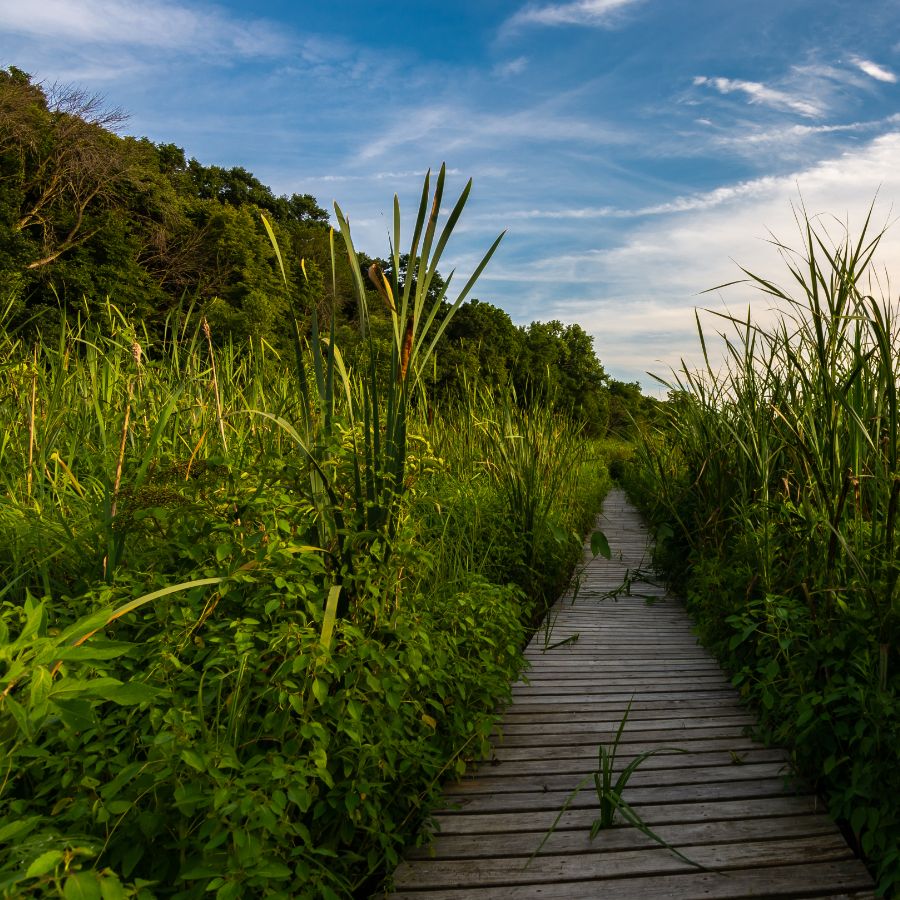
Dixon Memorial State Forest covers approximately 35,000 acres across Ware and Brantley counties in southeastern Georgia. This working forest demonstrates sustainable forestry practices while providing recreational opportunities.
Pine plantations dominate much of the landscape, but there are also natural hardwood areas along creeks and in lowlands. The forest is managed to support wildlife and maintain ecosystem health.
Truffle enthusiasts should focus on the mixed hardwood areas rather than the pine plantations. The best spots are often near the boundaries between different forest types. Look for mature oak trees, particularly in the eastern sections where the soil tends to be richer.
The forest’s network of roads and trails makes it accessible for foraging. Search in areas with minimal undergrowth where the soil receives filtered sunlight. The sloping grounds near small streams often create the perfect moisture conditions for truffles to thrive.
Other Great Locations For Truffles
| North Georgia Mountains | Collection Details |
|---|---|
| Arrowhead WMA | Hand-gather small truffles around the mixed pine–hardwood ponds for personal kitchen use. |
| Blue Ridge WMA | Surface pick-up of truffles in oak coves is permitted; avoid digging below leaf litter. |
| Chestatee WMA | Collect limited truffles along shaded hemlock–oak slopes on day hikes. |
| Cooper’s Creek WMA | Personal-use truffle foraging allowed beside rhododendron-lined creek benches. |
| Dawson Forest WMA | Visitors may hand-pick truffles on the Wildcat Creek and Burnt Mtn tracts. |
| Lake Burton WMA | Gather truffles along mature chestnut-oak ridges overlooking the lake. |
| Pine Log WMA | Personal harvest of truffles is permitted in the old-growth hardwood bottoms. |
| Rich Mountain WMA | Look for truffles beneath mountain laurel on north-facing slopes; hand pick only. |
| Sheffield WMA | Small-scale truffle collecting allowed along Raccoon Creek’s oak flats. |
| Warwoman WMA | Forage lightly for truffles in the mesic cove forests near waterfalls. |
| Upper Piedmont | Collection Details |
|---|---|
| B.F. Grant WMA | Personal truffle picking permitted under hickory groves along Lake Sinclair. |
| Bartram Forest WMA | Gather truffles among long-leaf pine islands and hardwood drains. |
| Big Indian Creek WMA | Collect small quantities beneath oak-beech ridges near the creek bluffs. |
| Cedar Creek WMA | Truffle foraging allowed along the Oconee River bottomlands—no tools needed. |
| Clybel WMA | Pick truffles in the gently rolling loblolly stands behind Charlie Elliott Center. |
| Coosawattee WMA | Search oak benches above Carter’s Lake for surface truffles, gathering by hand only. |
| Di-Lane WMA | Personal truffle collecting permitted in old-field pine transition zones. |
| Redlands WMA | Hand-harvest truffles in the mixed hardwood draws south of the Broad River. |
| Wilson Shoals WMA | Collect a few truffles along cool, north-slope hardwood coves off the US-365 ridge. |
| Central Georgia | Collection Details |
|---|---|
| Big Lazer Creek WMA | Personal truffle gathering allowed on hardwood knolls flanking the creek. |
| Blanton Creek WMA | Forage modestly for truffles in shaded beech-oak ravines. |
| Echeconnee Creek WMA | Pick truffles near the sandy creek terraces; hand tools not required. |
| Flint River WMA | Surface truffle collection permitted beneath pecan and oak flats by the river. |
| Oaky Woods WMA | Gather truffles on the upland pine ridges overlooking black-gum wetlands. |
| Ocmulgee WMA | Personal use truffle harvest allowed in the Gum Swamp Creek tract’s oak hammocks. |
| Rum Creek WMA | Collect truffles along cove hardwoods near Lake Juliette boat ramps. |
| Standing Boy Creek WMA | Hand-pick truffles in mixed hardwood slopes overlooking the Chattahoochee. |
| South Georgia | Collection Details |
|---|---|
| Chickasawhatchee WMA | Truffle foraging permitted in longleaf pine savannas south of Albany. |
| Clayhole Swamp WMA | Collect surface truffles on sandy islands within the tupelo-cypress swamp. |
| Doerun Pitcherplant Bog WMA | Hand-gather truffles under shaded oak rims bordering the pitcher-plant bogs. |
| Grand Bay WMA | Personal gathering allowed on pine hummocks scattered through the wetland complex. |
| Mayhaw WMA | Pick modest amounts of truffles beneath mixed river-bottom hardwoods. |
| River Creek WMA | Harvest truffles by hand along the live-oak corridors paralleling the Ochlockonee. |
| Silver Lake WMA | Search for truffles in wiregrass openings adjacent to longleaf pine stands. |
| Yuchi WMA | Collect truffles beneath sandy-ridge oak-pine woods overlooking the Savannah River. |
| Coastal Georgia | Collection Details |
|---|---|
| Altamaha WMA | Personal truffle gathering allowed along tidal bottomland hardwoods on the river bluffs. |
| Big Hammock WMA | Hand-pick truffles in xeric sand-hill oak forests bordering the Altamaha floodplain. |
| Ceylon WMA | Surface truffle harvest permitted beneath live-oak hammocks near Satilla River marshes. |
| Griffin Ridge WMA | Gather truffles on gently rolling pine ridges amidst laurel thickets. |
| Little Satilla WMA | Pick truffles on oak hummocks fringing the black-water creek. |
| Morgan Lake WMA | Collect small amounts under mature oaks on the lake’s western flats. |
| Sansavilla WMA | Truffle foraging allowed in pine-oak sand-ridge habitat northwest of Brunswick. |
| Townsend WMA | Harvest truffles by hand along mixed hardwood levees inside the river delta tracts. |
When The Best Time Of The Year Is To Find Truffles
Truffle hunting in Georgia works best during the cooler months. Most local truffles grow from November through February when the soil is nice and moist. These fungi need the cold weather to develop their flavor and scent.
Early morning hunts often bring the most success. The ground holds moisture better at this time of day. Rain also helps truffle hunters. Try going out a day or two after a good rainfall.
Different truffle types may appear at slightly different times. Pecan truffles often show up earlier in fall. The black Georgia truffles usually wait until deeper into winter.
One Final Disclaimer
The information provided in this article is for general informational and educational purposes only. Foraging for wild plants and mushrooms involves inherent risks. Some wild plants and mushrooms are toxic and can be easily mistaken for edible varieties.
Before ingesting anything, it should be identified with 100% certainty as edible by someone qualified and experienced in mushroom and plant identification, such as a professional mycologist or an expert forager. Misidentification can lead to serious illness or death.
All mushrooms and plants have the potential to cause severe adverse reactions in certain individuals, even death. If you are consuming foraged items, it is crucial to cook them thoroughly and properly and only eat a small portion to test for personal tolerance. Some people may have allergies or sensitivities to specific mushrooms and plants, even if they are considered safe for others.
Foraged items should always be fully cooked with proper instructions to ensure they are safe to eat. Many wild mushrooms and plants contain toxins and compounds that can be harmful if ingested.

